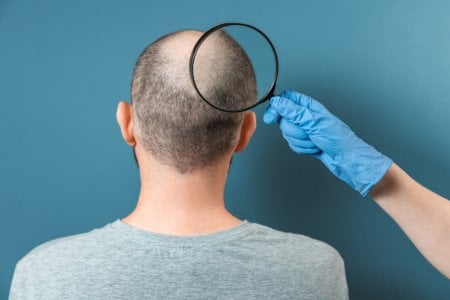Scientists Unveil Miracle Hair Growth Discovery Using a Natural Body Sugar - Could This Be the End of Baldness as We Know It?
By
Seia Ibanez
- Replies 3
In a world where a full head of hair is often associated with youth and vitality, the quest for a solution to male pattern baldness has been relentless. For many men over 60, hair loss can be a source of anxiety and a hit to self-confidence. But there's a glimmer of hope on the horizon, as scientists have made a breakthrough that could change the lives of millions.
Researchers from the University of Sheffield, alongside colleagues from COMSATS University Pakistan, have stumbled upon a remarkable discovery: a naturally occurring sugar in the human body, known as 2-deoxy-D-ribose (2dDR), has the potential to stimulate hair growth. This sugar, a component of our DNA, could be the key to unlocking a future where baldness is a choice rather than an inevitability.
The study, which initially aimed to explore the sugar's effects on wound healing, revealed that when applied as a gel, 2dDR encourages the growth of blood vessels in the skin. This, in turn, could lead to faster wound closure. However, a serendipitous observation showed that the areas around the wounds where the gel was applied also experienced rapid hair regrowth.
Intrigued by this unexpected side effect, the researchers conducted further experiments using mice as models for male pattern baldness. By treating the mice with testosterone to induce hair loss similar to that experienced by humans, and then applying 2dDR, minoxidil (commonly known as Rogaine), or a combination of both, they observed significant hair regrowth. Remarkably, both 2dDR and minoxidil promoted an 80 to 90 percent regrowth rate, although combining the treatments did not enhance the effect.
This discovery is particularly exciting for those who have been less than satisfied with current hair loss treatments. Minoxidil, while effective for some, does not work for everyone and can be a slow process. Finasteride, another FDA-approved treatment, comes with the risk of severe side effects, including sexual dysfunction and depression. The potential of a naturally occurring sugar to promote hair growth without altering sex hormone levels offers a promising alternative.
Professor Sheila MacNeil of the University of Sheffield expressed optimism about the findings, suggesting that this simple sugar could be a new approach to treating a condition that deeply affects men's self-image and confidence. The treatment works by enhancing blood supply to the hair follicles, encouraging the growth of thick, long hair.
However, it's important to note that while these results are promising, more research is needed to confirm the effectiveness and safety of 2dDR in humans. The journey from a laboratory breakthrough to a widely available treatment can be long and complex, involving rigorous testing and regulatory approval.
For our readers at the Seniors Discount Club, this news could be a beacon of hope. Hair loss is a common concern among older adults, and the possibility of a new, natural treatment is certainly worth following. As we await further developments, it's a reminder that science continues to advance and offer solutions to age-old problems.

We'd love to hear your thoughts on this exciting discovery. Have you struggled with hair loss, and would you consider trying a treatment like this if it becomes available? Share your experiences and opinions in the comments below. Let's keep the conversation going about the future of hair loss treatments and the impact they could have on our lives.
Researchers from the University of Sheffield, alongside colleagues from COMSATS University Pakistan, have stumbled upon a remarkable discovery: a naturally occurring sugar in the human body, known as 2-deoxy-D-ribose (2dDR), has the potential to stimulate hair growth. This sugar, a component of our DNA, could be the key to unlocking a future where baldness is a choice rather than an inevitability.
The study, which initially aimed to explore the sugar's effects on wound healing, revealed that when applied as a gel, 2dDR encourages the growth of blood vessels in the skin. This, in turn, could lead to faster wound closure. However, a serendipitous observation showed that the areas around the wounds where the gel was applied also experienced rapid hair regrowth.
Intrigued by this unexpected side effect, the researchers conducted further experiments using mice as models for male pattern baldness. By treating the mice with testosterone to induce hair loss similar to that experienced by humans, and then applying 2dDR, minoxidil (commonly known as Rogaine), or a combination of both, they observed significant hair regrowth. Remarkably, both 2dDR and minoxidil promoted an 80 to 90 percent regrowth rate, although combining the treatments did not enhance the effect.
This discovery is particularly exciting for those who have been less than satisfied with current hair loss treatments. Minoxidil, while effective for some, does not work for everyone and can be a slow process. Finasteride, another FDA-approved treatment, comes with the risk of severe side effects, including sexual dysfunction and depression. The potential of a naturally occurring sugar to promote hair growth without altering sex hormone levels offers a promising alternative.
Professor Sheila MacNeil of the University of Sheffield expressed optimism about the findings, suggesting that this simple sugar could be a new approach to treating a condition that deeply affects men's self-image and confidence. The treatment works by enhancing blood supply to the hair follicles, encouraging the growth of thick, long hair.
However, it's important to note that while these results are promising, more research is needed to confirm the effectiveness and safety of 2dDR in humans. The journey from a laboratory breakthrough to a widely available treatment can be long and complex, involving rigorous testing and regulatory approval.
For our readers at the Seniors Discount Club, this news could be a beacon of hope. Hair loss is a common concern among older adults, and the possibility of a new, natural treatment is certainly worth following. As we await further developments, it's a reminder that science continues to advance and offer solutions to age-old problems.
Key Takeaways
- Scientists have potentially found a cure for male pattern baldness using a natural sugar that stimulates hair growth.
- The sugar, 2-deoxy-D-ribose (2dDR), showed encouraging results in promoting hair regrowth in mice similar to the effects of the drug minoxidil.
- The breakthrough discovery was made while investigating wound healing and could lead to a simpler, more natural treatment for hair loss.
- While the findings are promising, further research is needed, and the sugar gel could provide a safe and cost-effective alternative to current hair loss treatments.
We'd love to hear your thoughts on this exciting discovery. Have you struggled with hair loss, and would you consider trying a treatment like this if it becomes available? Share your experiences and opinions in the comments below. Let's keep the conversation going about the future of hair loss treatments and the impact they could have on our lives.








